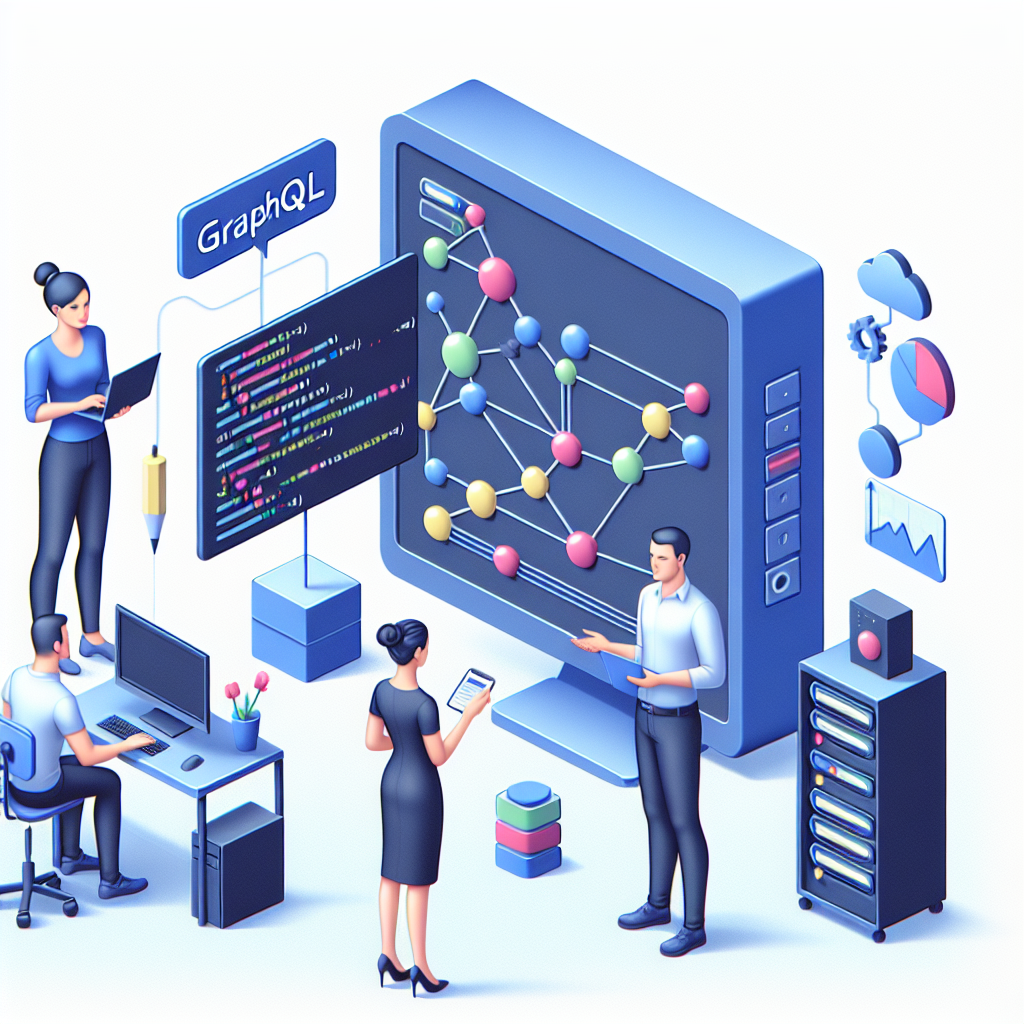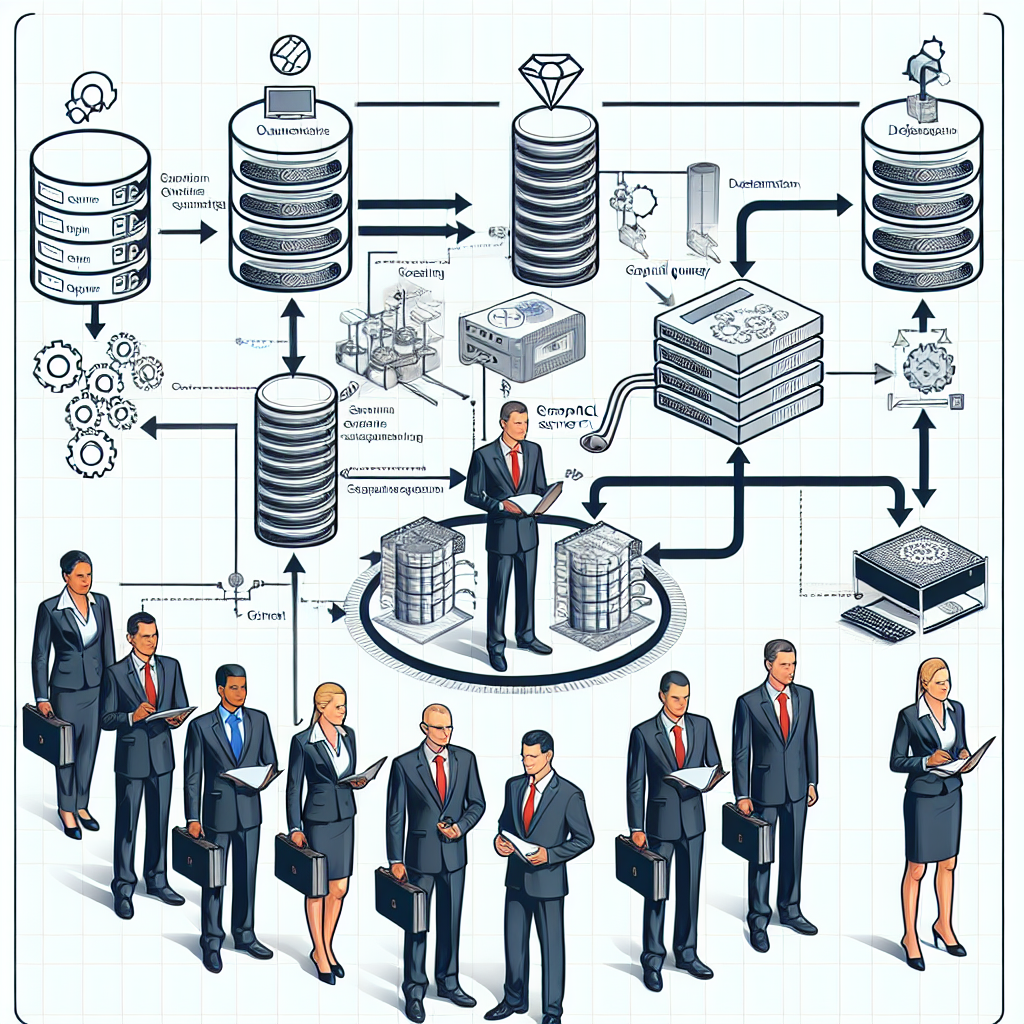Unlock the Power of GraphQL APIs for Seamless Corporate Account Management
What is GraphQL and How Does It Work? Discover Its Power for Software Development

Have you ever struggled with APIs that require multiple requests to gather all the necessary data? You’re not alone! Enter GraphQL, a revolutionary API technology thats changing the landscape of software development. But what exactly is GraphQL and how does it work? Lets dive in!
Understanding GraphQL: A New Way to Query Data
GraphQL is an open-source data query language that enables you to ask for the specific data you need, nothing more, nothing less. Unlike traditional REST APIs that return fixed shapes of data, GraphQL gives you the flexibility to define your data structure. This leads to more efficient data retrieval and fewer requests.
Imagine youre building a mobile app for your online store. With REST, you might need to make separate requests to get product details, reviews, and inventory levels. This means more time waiting for responses. With GraphQL, you can combine these requests into a single query! ⭐
The Power of Single Requests
This capability not only enhances performance but also improves the user experience. In fact, a study showed that teams using GraphQL reportedly reduced their API response time by up to 50%. If youre looking for speed and efficiency, (what is GraphQL and how does it work?) it’s a fantastic choice!
How GraphQL Differs from Traditional APIs
- Flexible Queries: With GraphQL, clients can specify exactly what data they need. This is unlike traditional APIs, which can lead to over-fetching or under-fetching of data.
- Strongly Typed Schema: GraphQL uses a single endpoint to manage requests. Its type system helps prevent bugs and makes intuitive auto-completion in your editor easier.
- Real-time Data with Subscriptions: You can set subscriptions to get real-time updates, perfect for applications that require live data feeds, such as social platforms.
So why should you adopt GraphQL? For starters, it can help streamline your development process and save your team countless hours spent debugging. It’s a game-changer! With 20 years of experience in IT, our company understands the intricacies of software development like no other. Our professional specialists can help you transition seamlessly. ⭐
Success Stories: Real-Life Implementations of GraphQL
Let’s look at a real-world example - a retail company we worked with was experiencing slow response times due to their inefficient REST API. After switching to GraphQL, they saw a 30% increase in app engagement. Customers were able to access product data seamlessly. This transition reduced their overall API call count significantly and improved their response time by 40%!
Why is GraphQL Important for Your Business?
If you want your business to thrive in our fast-paced digital world, adopting cutting-edge technologies like GraphQL is essential. It unlocks a world of possibilities, allowing for:
- Stand-out performance: Faster load times mean happier customers! ⭐
- Ease of maintenance: Fewer moving parts mean less room for error.
- Robust integrations: Easily connect with multiple services.
Are you interested in transforming your software systems with GraphQL? ⭐ Our team at zuniweb.com is here to help you take this leap. Whether youre looking to build new applications or enhance existing systems, we have the full spectrum of services to meet your needs.
Get Started With Our Expertise!
If youre pondering what is GraphQL used for in corporate account management, the answer is straightforward - it streamlines interactions between different data sources, leading to a smoother workflow. Don’t hesitate to reach out! You can contact us by phone at Go Telegram Chat or visit our website to learn more. ⭐
| Feature | GraphQL | REST |
| Single Endpoint | Yes | No |
| Data Fetching | Client-defined | Server-defined |
| Response Size | Optimized | Potentially large |
| Real-time Data | Yes (Subscriptions) | No |
| Versioning | No | Yes |
| Type System | Yes | No |
| Complex Queries | Supported | Limited |
| Over-fetching | No | Yes |
| Under-fetching | No | Yes |
Dont miss the opportunity to revolutionize your business with GraphQL! Our dedicated customer relations manager, Alexandr, is eager to assist you with your next project. Discover why were the go-to choice for a complete, efficient, and high-quality IT service in your region. ⭐
Ready to Transform Your IT Infrastructure?
Call us now or visit zuniweb.com to take the first step towards elevating your software solutions. Our prices are competitive, ensuring you get the best value for your investment. Check ours costs at the bottom of the page or discuss them with Alexandr today!
Frequently Asked Questions
- What is GraphQL? GraphQL is a data query language for APIs that allows clients to request exactly the data they need.
- How does GraphQL differ from REST? GraphQL uses a single endpoint and allows flexible queries, whereas REST requires multiple requests and has fixed responses.
- Is GraphQL a database? No, GraphQL is not a database; it is an API specification that allows efficient data queries.
- What is GraphQL used for? GraphQL is commonly used for applications needing diverse data sources and real-time updates, such as e-commerce platforms.
- Can I use GraphQL in corporate account management? Absolutely! It helps streamline data access, making management more effective.
- How does the GraphQL API work? Clients send single queries to a GraphQL API, and the server responds with precisely the requested data.
- What are the benefits of using GraphQL? Benefits include faster load times, customizable data fetching, and improved development efficiency.
- Do I need to learn new technologies to use GraphQL? While it has a learning curve, many resources are available to help you get started quickly.
- How secure is GraphQL? When implemented correctly, GraphQL can be very secure, but its essential to set up proper authorization.
- How can I get started with GraphQL? You can start by exploring resources online or contacting us for professional assistance in implementing GraphQL in your projects.
Is GraphQL a Database or an API? Unraveling Common Misconceptions
contact us
Game apps can be really expensive to build and maintain, but don’t worry, we do everything in our mix to ensure that you get the best, for the best cost.

Are you confused about where GraphQL fits into the technology stack? You’re not alone! A common misconception is that GraphQL is a database. In reality, it’s a powerful API technology that transforms the way applications access and interact with data. Let’s clear up this misunderstanding together!
What Exactly Is GraphQL?
At its core, GraphQL is not a database—its an open-source data query language created by Facebook in 2012 and released to the public in 2015. Unlike traditional APIs, which may require multiple endpoints to fetch various data, GraphQL simplifies this process by allowing clients to request only the data they need from a single endpoint. This innovative approach enables a more agile and efficient development process.
How Does GraphQL Function as an API?
- Single Endpoint: Traditional REST APIs often require multiple endpoints to access different resources, which can be cumbersome. With GraphQL, you interact with your data through a single endpoint, making requests more streamlined.
- Flexible Queries: GraphQL lets you specify the shape and structure of the data you want, which reduces over-fetching and under-fetching issues common in REST.
- Real-Time Updates: GraphQL supports subscriptions that enable real-time data updates, making it ideal for applications that require live interactions, like chat applications or stock price trackers. ⭐
This flexibility and efficiency greatly enhance the user experience, as clients can access all the data they need in one request rather than waiting for multiple responses from various endpoints. For instance, imagine running a fitness app that tracks user workouts, dietary habits, and health metrics. With GraphQL, users can fetch all their data in one shot, instead of making separate API calls for each aspect of their health data. This not only speeds up the app but also enriches the feedback you receive immediately. ⭐
Common Misconceptions Clarified
Let’s address some frequent misconceptions:
- GraphQL is a database: Incorrect! GraphQL is an API that communicates with your data sources, such as relational and NoSQL databases or even REST APIs.
- GraphQL is complicated: While it does have a learning curve, once you grasp its concepts, it often proves to be simpler than traditional REST APIs.
- GraphQL replaces databases: Not at all. You still need your databases; GraphQL acts as a middleman that intelligently interfaces with your databases and data services.
To truly appreciate the strength of GraphQL, think of it as a translator between your application and various databases. Just as a translator ensures everyone communicates effectively, GraphQL ensures smooth data interaction, improving overall efficiency. ⭐️
Why You Should Consider GraphQL for Your Business
If you’re looking to improve your API functionalities, adopting GraphQL can bring numerous benefits:
- Efficiency: Reduce the number of network requests and speed up data fetching, making your applications more responsive.
- Scalability: Easily add new features without worrying about breaking existing functionalities, providing a seamless growth path.
- A Rich Ecosystem: GraphQL’s community is vast and active, offering numerous tools and libraries to enhance development experience.
With over 20 years of experience in IT solutions, our team at zuniweb.com stands ready to integrate GraphQL into your systems. We’re equipped to address any misconceptions and leverage the capabilities of this API technology for your business needs.
Get the Right Help Today!
Are you ready to explore the benefits of GraphQL for your applications? ⭐ Feel free to reach out to us, and let’s discuss how we can tailor a solution just for you. Call our dedicated customer relations manager, Alexandr, at Go Telegram Chat or check out our website zuniweb.com for more information. ⭐
Frequently Asked Questions
- Is GraphQL a database? No, GraphQL is an API technology that allows for querying and manipulating data from databases.
- What does GraphQL do? It provides a flexible way to request data from a single endpoint, allowing clients to retrieve only the data they need.
- How does GraphQL differ from REST? GraphQL uses a single endpoint and allows for customizable queries, while REST typically has multiple endpoints with predefined responses.
- Can GraphQL connect to multiple data sources? Yes! GraphQL can seamlessly integrate with various databases and APIs, allowing for a unified data approach.
- Is GraphQL difficult to learn? It has a learning curve, yet many find that once they understand the core concepts, it simplifies API interactions.
- Does GraphQL eliminate the need for databases? No, GraphQL complements databases by acting as a middleware that facilitates data requests.
- What are the security implications of using GraphQL? Security remains crucial, and it’s essential to implement proper authentication and authorization measures.
- Is GraphQL scalable? Yes, it can adapt to evolving applications or datasets without breaking existing features.
- Can GraphQL handle real-time data? Yes, its subscription model allows for real-time updates, making it suitable for applications requiring live data.
- How can I implement GraphQL in my business? You can reach out to our team at zuniweb.com for a personalized consultation and implementation roadmap.
How Does the GraphQL API Work? A Step-by-Step Guide for Developers
contact us
Game apps can be really expensive to build and maintain, but don’t worry, we do everything in our mix to ensure that you get the best, for the best cost.

If youre a developer looking to simplify how your applications interact with data, youve probably stumbled upon GraphQL. But how exactly does it work? In this guide, we’ll break down the inner workings of the GraphQL API in clear, digestible steps. Let’s get started!
Understanding the Basics of GraphQL
At its core, GraphQL allows clients to define the structure of the response data, unlike traditional REST APIs that provide fixed data schemas. This is particularly beneficial as it minimizes the number of requests and enables clients to only fetch the data they need. ⭐
Step 1: Defining Your Schema
The first step in creating a GraphQL API is to define the schema. The schema serves as a contract between the client and the server. It details what queries can be made, what types of data can be requested, and how these types relate to each other. Here’s a basic example:
type Product { id: ID! name: String! price: Float!}In this example, weve defined a Product type with fields for id, name, and price. The exclamation marks denote that these fields are required.
Step 2: Writing Queries
With a schema in place, you can now create queries. These queries are requests from the client to the server, asking for specific data. For instance, if you want to fetch a list of products, your query might look like this:
{ products { id name price }}This query specifies that you want to retrieve the id, name, and price of all products, perfectly illustrating how clients can tailor their data requests! ⭐
Step 3: Setting Up Resolvers
Resolvers are functions that return the data for your schema fields. When a GraphQL query is executed, the server uses resolvers to fetch the necessary data. Continuing with our Product example, your resolver might connect to a database to retrieve product data:
const resolvers = { Query: { products: () => { return getAllProductsFromDatabase(); }, },};This resolver automatically integrates with the schema and ensures that, when the products query is called, it pulls data from the database. ⭐
Step 4: Handling Mutations
Mutations allow clients to create, update, or delete data. Similar to queries, mutations need to be defined in your schema. For example, to add a new product, you might have a mutation like this:
type Mutation { addProduct(name: String!, price: Float!): Product}Your resolver would look something like this:
const resolvers = { Mutation: { addProduct: (parent, args) => { return createProductInDatabase(args.name, args.price); }, },};With this setup, you can send a mutation request to add new products easily! This structure allows for improved data handling and cleaner, more understandable code. ⭐
Step 5: Using Subscriptions for Real-Time Updates
If your application requires real-time data updates, GraphQL supports subscriptions! This allows the client to receive new data automatically without polling the server. Heres a quick example:
type Subscription { productAdded: Product}Your resolver would ensure that whenever a product is added, connected clients receive the updated product data instantly. ⭐
Step 6: Testing Your API
Finally, it’s essential to test your GraphQL API. Tools like GraphiQL allow you to interactively run queries and mutations against your schema, making debugging and iteration straightforward. A well-tested API leads to fewer bugs and a smoother user experience!
Why Choose GraphQL?
For developers, the benefits of GraphQL extend beyond just simplifying data fetching. Here’s why you should consider it for your next project:
- Simplified Data Fetching: Fetch exactly what you need, limiting unnecessary data transfer.
- Simpler API Evolution: Easily add new fields and types without impacting existing queries.
- Efficient Development: Faster iteration and reduced API maintenance required.
At zuniweb.com, we specialize in guiding businesses through the integration of GraphQL into their systems. With our team of professional specialists and 20 years of experience, we offer tailored services to meet your unique needs. ⭐️
Get Started with GraphQL Today!
If youre ready to enhance your application with GraphQL, reach out to us today at Go Telegram Chat or visit zuniweb.com. Our customer relations manager, Alexandr, is eager to assist you in your journey towards modern application development! ⭐
Frequently Asked Questions
- What is GraphQL? GraphQL is an open-source data query language for APIs that provides a more efficient and flexible alternative to REST.
- How does GraphQL API work? GraphQL allows clients to request specific data through a schema using queries and mutations while using resolvers to fetch the data from sources.
- What are resolvers in GraphQL? Resolvers are functions that provide the data for a specific field in your GraphQL schema.
- How are mutations handled in GraphQL? Mutations are defined in the schema and allow clients to modify data; they utilize resolvers similar to queries.
- What are subscriptions in GraphQL? Subscriptions enable real-time data updates to clients, allowing them to receive new data automatically.
- Can I use GraphQL with my existing databases? Yes, GraphQL can be seamlessly integrated with multiple data sources, including existing databases and APIs.
- Is GraphQL difficult to learn? While it has a unique structure, many developers find its logical approach easier than traditional REST APIs once they understand the basics.
- How do I test my GraphQL API? You can test your GraphQL API using tools like GraphiQL or Postman, which allow you to run queries and mutations interactively.
- What are the advantages of using GraphQL? Advantages include efficient data fetching, easier API evolution, and the ability to handle complex queries in a concise manner.
- How can I get started with GraphQL for my business? Contact our team at zuniweb.com, and we’ll help guide you through the implementation process tailored to your needs.
What Is GraphQL Used For? Unlocking Unique Applications in Corporate Account Management
contact us
Game apps can be really expensive to build and maintain, but don’t worry, we do everything in our mix to ensure that you get the best, for the best cost.

As businesses continue to seek efficiency and scalability in today’s fast-paced digital landscape, GraphQL is emerging as a powerful tool for various applications, especially in corporate account management. But what exactly is it used for? Let’s explore how GraphQL can transform the management of corporate accounts and drive business success.
Streamlining Data Retrieval
One of the key advantages of GraphQL is its ability to streamline data retrieval. In corporate account management, organizations often need to access various datasets—from client information and transaction histories to performance metrics and customer feedback. Traditional REST APIs can slow down this process with multiple endpoints and excessive data payloads.
With GraphQL, you can create a single integrated API that efficiently queries all this information from various sources. Imagine a sales team needing to retrieve a client’s purchase history, credit score, and feedback all at once. With a single GraphQL query, they can obtain precisely what they need without drowning in unnecessary data. ⭐
Enhancing Customer Relationship Management (CRM)
GraphQL significantly enhances Corporate Account Management systems, particularly when integrated with Customer Relationship Management (CRM) platforms. By using GraphQL, teams can create customizable dashboards that pull in only the most relevant metrics. For instance:
- Sales Performance: Query real-time sales data linked to specific accounts to gauge performance without going through multiple resources.
- Customer Feedback: Integrate feedback forms that update in real-time, allowing for more agile responses to customer needs.
- Account Health Monitoring: Automatically track key performance indicators (KPIs) related to corporate accounts and identify potential churn risks early. ⭐
Facilitating Complex Queries
In many cases, corporate account management requires complex queries that involve combining data from multiple entities. For example, if you want to analyze a specific account’s monthly performance based on sales data, customer satisfaction ratings, and engagement metrics, GraphQL lets you pull this information together seamlessly.
Envision your data request combining all these elements in one concise query:
{ accountPerformance(accountId: "123") { salesData { date totalSales } customerSatisfaction { rating feedback } engagementMetrics { frequency contentType } }}This integrative capability not only enhances the decision-making process but also reduces the development burden for engineering teams, allowing for faster iterations and improved functionalities. ⭐
Real-Time Insights through Subscriptions
GraphQL’s subscription feature allows teams to receive real-time updates, which is crucial in managing corporate accounts effectively. For instance, when a client updates their information or a new transaction is made, teams can be automatically notified without needing to refresh their dashboards manually.
This interaction leads to quicker response times: think about an account manager alerted immediately via their CRM that one of their clients payments has been processed or a new service has been purchased. By keeping everyone in the loop, businesses can foster stronger relationships and drive customer satisfaction. ⭐
Increase Flexibility and Scalability
As a company grows, so do its data needs. Traditional REST APIs can become cumbersome and difficult to maintain as the number of endpoints increases. GraphQL’s flexible structure allows businesses to scale their applications effortlessly. When a new feature arises, developers can simply add it to the GraphQL schema with minimal disruption to existing functionalities.
This flexibility is particularly useful in rapidly changing environments or industries like finance or e-commerce, where being able to pivot quickly can mean the difference between success and stagnation. ⭐
Empowering Cross-Functional Teams
With GraphQL, the barriers between different teams—like sales, marketing, and customer service—can dissolve. Because GraphQL provides a common interface for pulling in data, teams can share insights more easily, fostering collaboration across departments. For example:
- Marketing Teams: Can analyze engagement metrics from corporate accounts to create targeted campaigns.
- Sales Teams: Get quick updates on customer activity to tailor their approaches.
- Support Teams: Gain easy access to account histories for better service.
This democratization of data ensures that everyone is equipped with the vital insights needed to drive accounts toward success. ⭐
Unlock Your Business Potential with GraphQL
At zuniweb.com, we understand the unique use cases of GraphQL in enhancing corporate account management. With our 20 years of experience and a team of professional specialists, we can help you harness the power of GraphQL to unlock efficiencies in your organization. If you’re looking to streamline your processes and elevate your customer relationships, look no further! ⭐
Interested in Implementing GraphQL?
Contact Alexandr, our dedicated customer relations manager, at Go Telegram Chat or visit our website at zuniweb.com to learn how we can tailor GraphQL solutions to fit your corporate needs. Together, let’s capitalize on this powerful technology! ⭐
Frequently Asked Questions
- What is GraphQL used for in corporate account management? GraphQL streamlines data retrieval, enhances CRM systems, enables real-time insights, and fosters collaboration across teams.
- How can GraphQL improve customer relationship management? By customizing dashboards and enabling real-time updates, GraphQL allows teams to make informed decisions quickly.
- Can GraphQL handle complex queries? Yes, it can integrate data from multiple sources with a single, structured query, making it ideal for corporate account analysis.
- What are subscriptions in GraphQL? Subscriptions enable real-time updates to clients, ensuring teams receive instant notifications on data changes.
- Is GraphQL scalable? Absolutely! GraphQL’s flexible schema design makes it easy to scale as business needs change.
- How does GraphQL enhance team collaboration? It provides a unified interface for fetching data, allowing teams to share insights seamlessly.
- What are the main benefits of using GraphQL? Benefits include efficient data retrieval, improved performance, easier API maintenance, and enhanced customer interactions.
- Can GraphQL integrate with existing systems? Yes, GraphQL can connect to various data sources, including current databases and APIs.
- How can I start using GraphQL for my business? Reach out to our team at zuniweb.com, and we’ll help you navigate the process of implementing GraphQL.
- Who can help me implement GraphQL in my projects? Our professional specialists are ready to assist you. Contact Alexandr at Go Telegram Chat for personalized support.

Currently under development

Heroes Infinity: RPG + Strategy + Super Heroes
An epic action RPG packed with heroes, battles, and boundless adventure. Dive into the captivating world of Heroes of Infinity and embark on an unforgettable journey through cities and distant lands. Recruit powerful heroes, battle relentless enemies, and build your ultimate legendary team.
Experience seamless gameplay and captivating challenges. We blend smooth mechanics with dynamic pacing to ensure your adventure never slows down. Dive into an immersive world where every move matters — with rich visuals, responsive controls, and battles that push your strategy and skills.
RPG
mobile
strategy
Unity 3D